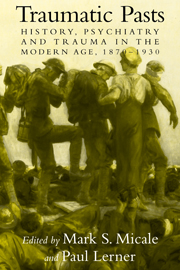Book contents
- Frontmatter
- Contents
- Contributors
- Preface
- 1 Trauma, Psychiatry, and History: A Conceptual and Historiographical Introduction
- Part One Travel and Trauma in the Victorian Era
- Part Two Work, Accidents, and Trauma in the Early Welfare State
- Part Three Theorizing Trauma: Psychiatry and Modernity at the Turn of the Century
- Part Four Shock, Trauma, and Psychiatry in the First World War
- Index
- Titles in the series
1 - Trauma, Psychiatry, and History: A Conceptual and Historiographical Introduction
Published online by Cambridge University Press: 14 October 2009
- Frontmatter
- Contents
- Contributors
- Preface
- 1 Trauma, Psychiatry, and History: A Conceptual and Historiographical Introduction
- Part One Travel and Trauma in the Victorian Era
- Part Two Work, Accidents, and Trauma in the Early Welfare State
- Part Three Theorizing Trauma: Psychiatry and Modernity at the Turn of the Century
- Part Four Shock, Trauma, and Psychiatry in the First World War
- Index
- Titles in the series
Summary
In light of the catastrophes and cataclysms that have marked twentieth-century history, it is scarcely surprising that trauma has emerged as a highly visible and widely invoked concept. Having transcended its origins in clinical medicine to enter everyday culture and popular parlance, trauma has become a metaphor for the struggles and challenges of late twentieth-century life, a touchstone in a society seemingly obsessed with suffering and victimization. Simultaneously, the concept of trauma itself has inspired vigorous criticism, resulting in a series of highly publicized medical and legal controversies. Indeed, debates over the nature, “reality,” and significance of traumatic suffering have had enormous cultural resonance as we struggle to make sense of a ceaselessly violent and chaotic world.
THE BACKGROUND OF HISTORICAL TRAUMA STUDIES
As a category in psychological medicine, trauma was given official recognition by the American Psychiatric Association in 1980 in the form of Posttraumatic Stress Disorder (PTSD). The APA's authoritative Diagnostic and Statistical Manual of Mental Disorders, the psychiatric bible that names and classifies all nervous and mental disorders, granted post-traumatic psychological suffering the status of a discrete and independent diagnostic entity in its third edition. According to the 1980 definition, PTSD is precipitated by an event that would cause great distress to almost anyone; and with the revised 1987 edition came the added stipulation that such an event must lie “outside the range of usual human experience.”
- Type
- Chapter
- Information
- Traumatic PastsHistory, Psychiatry, and Trauma in the Modern Age, 1870–1930, pp. 1 - 28Publisher: Cambridge University PressPrint publication year: 2001
- 12
- Cited by



